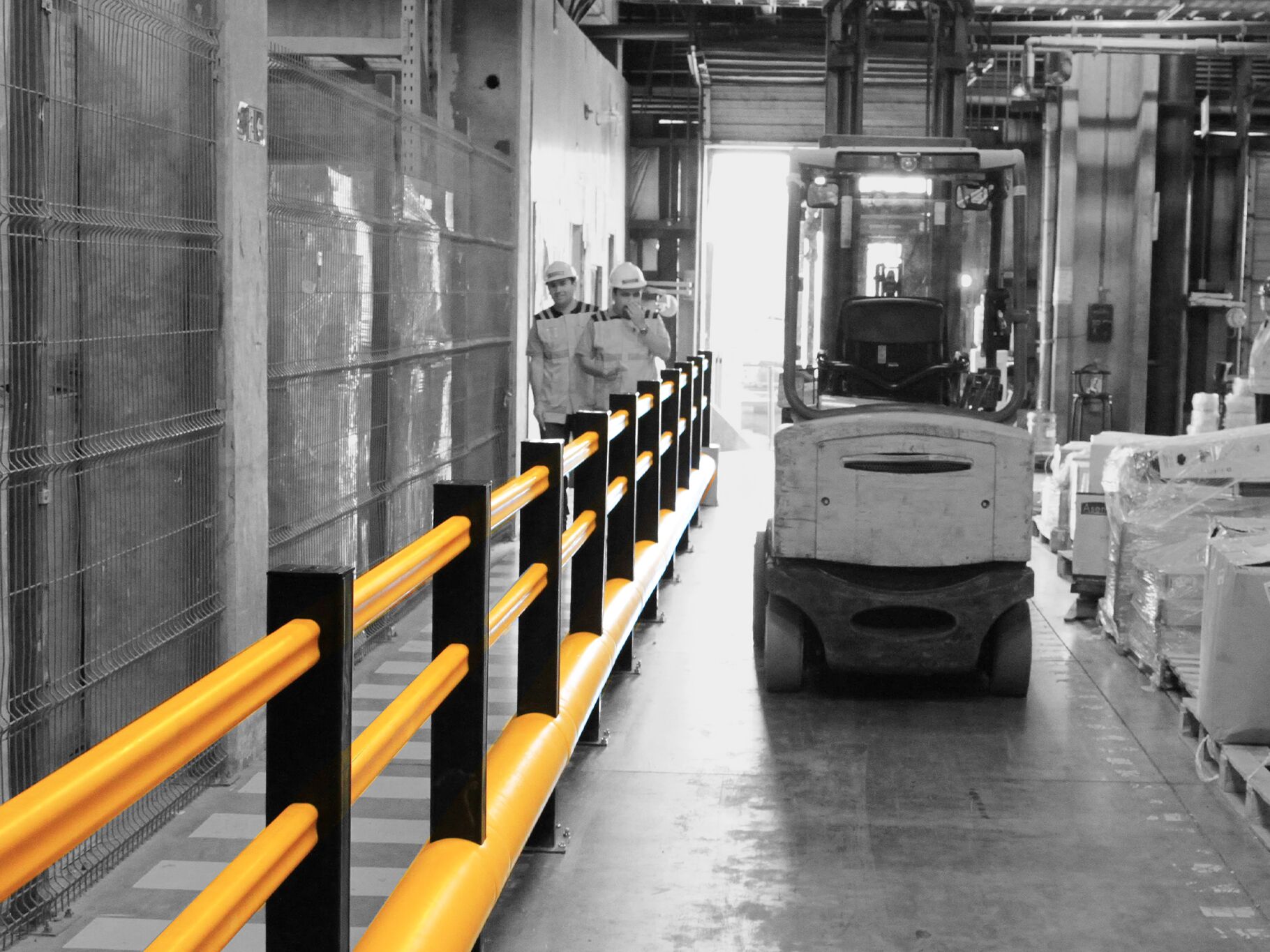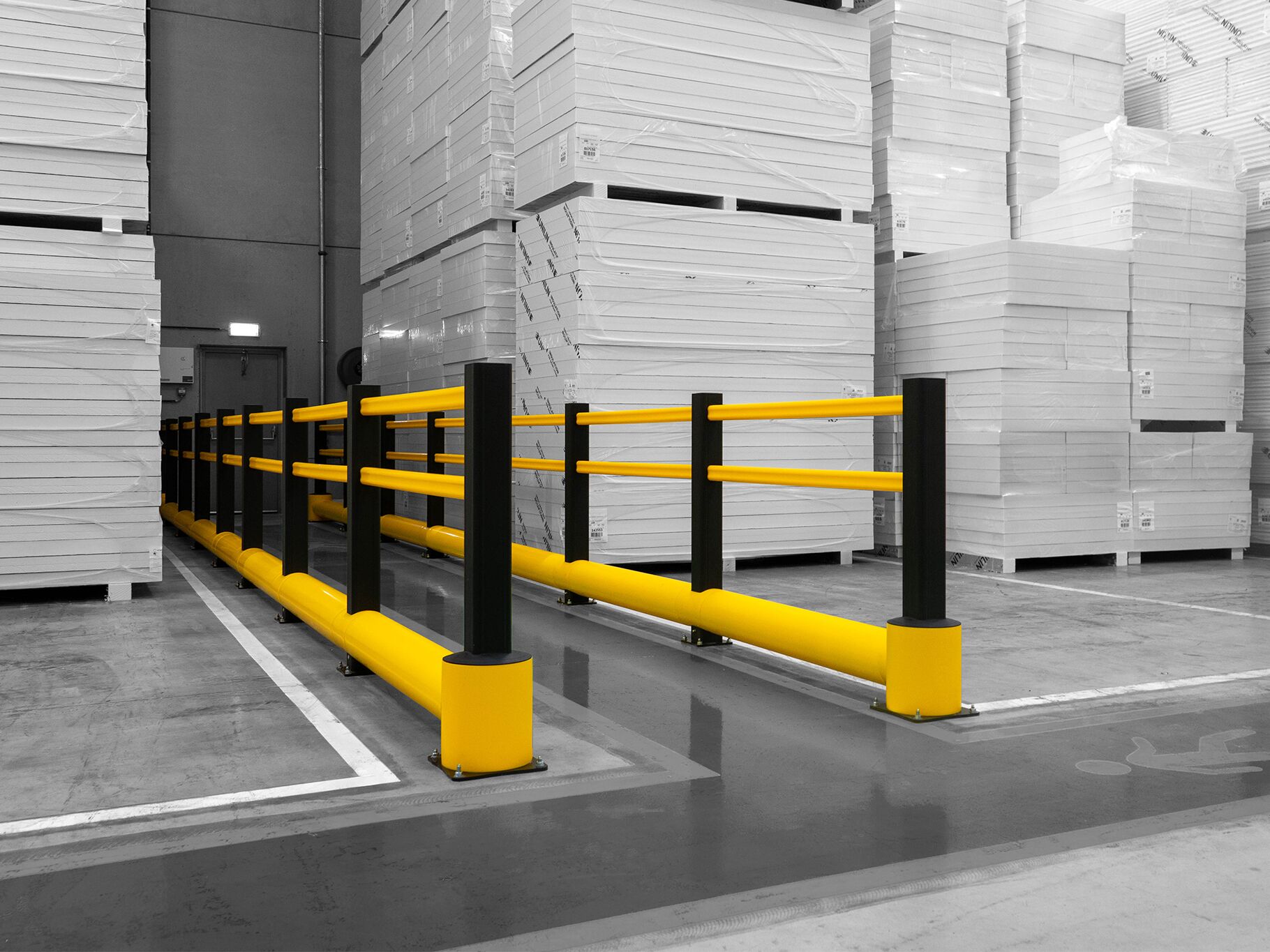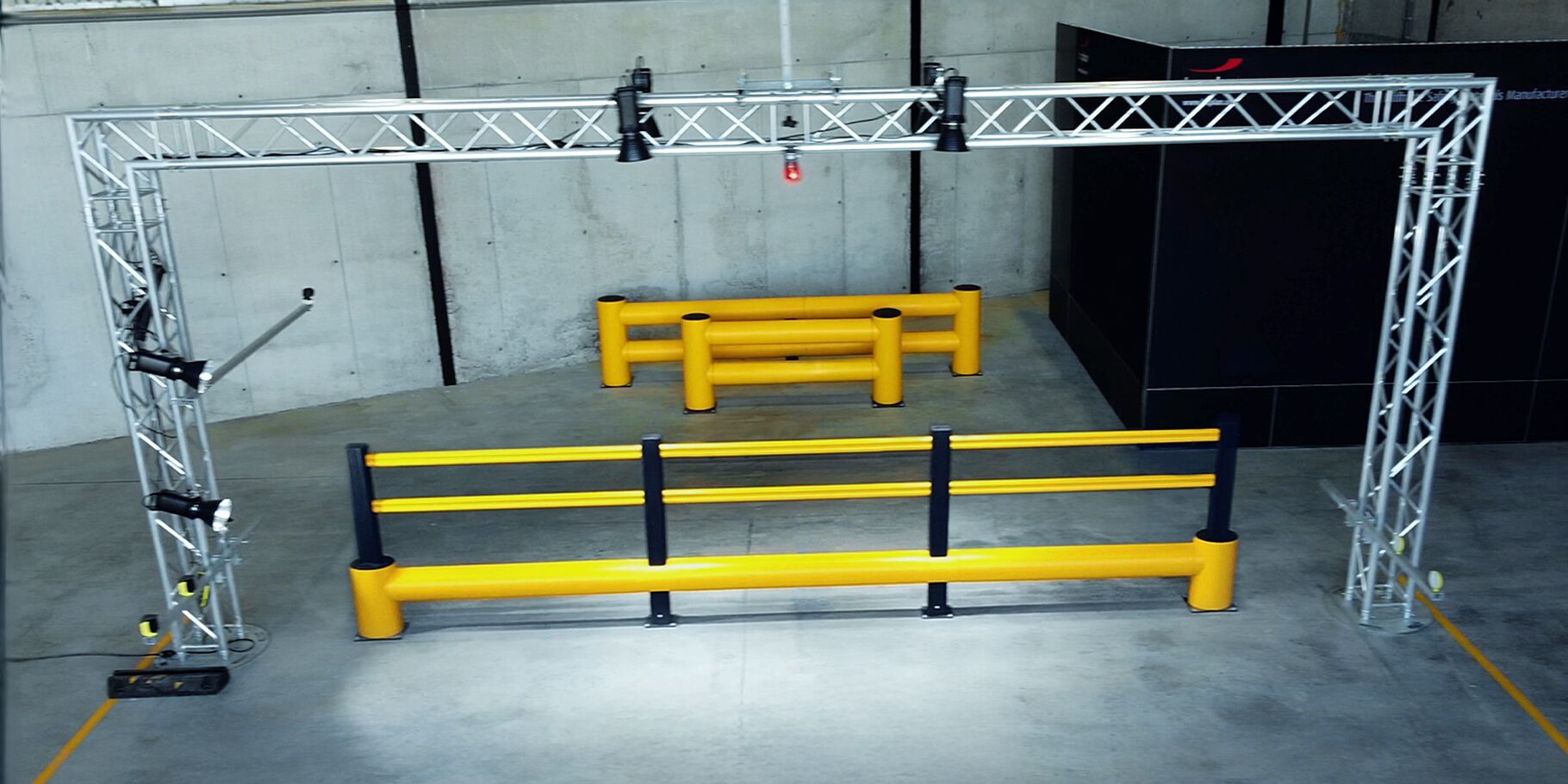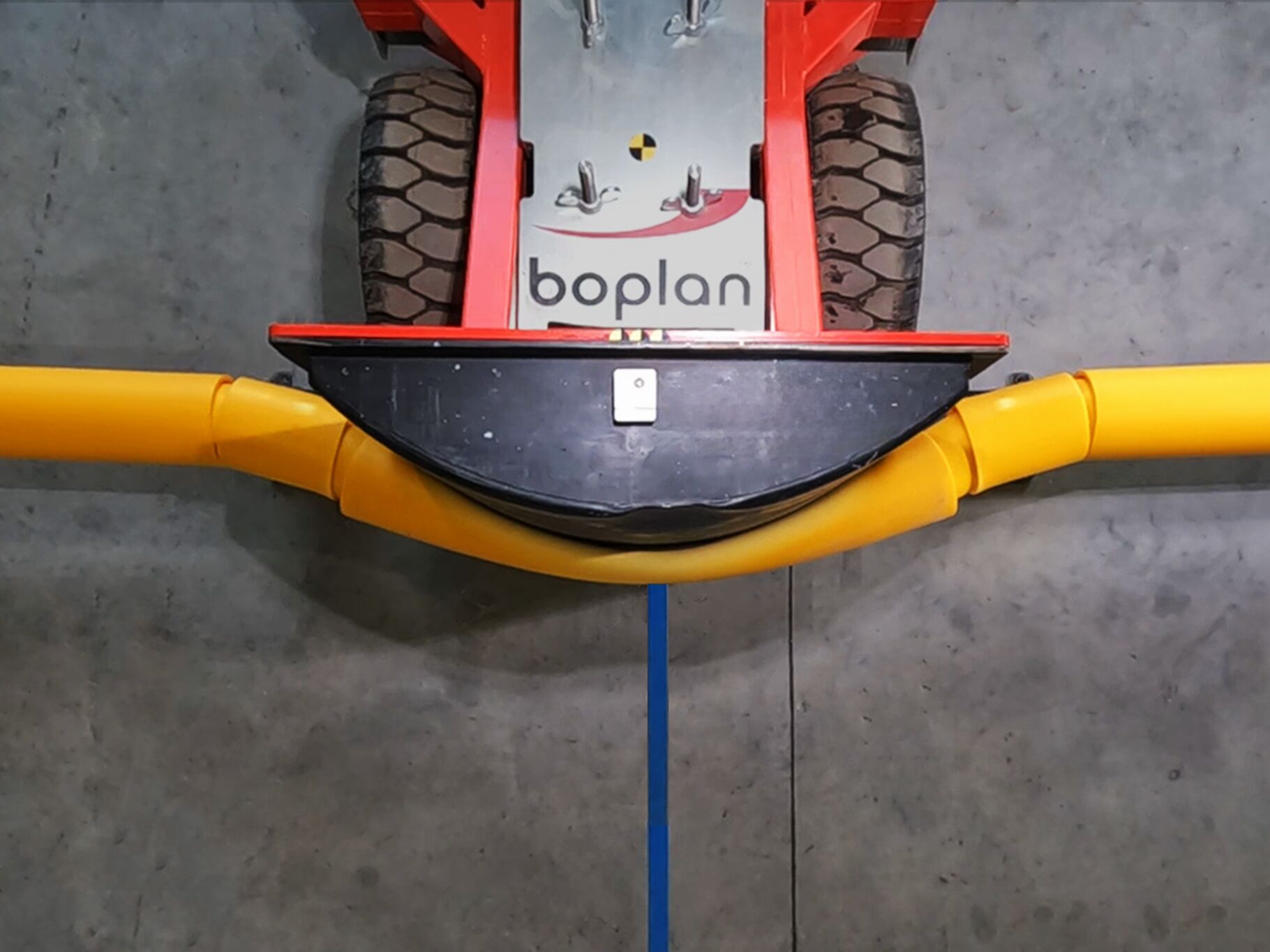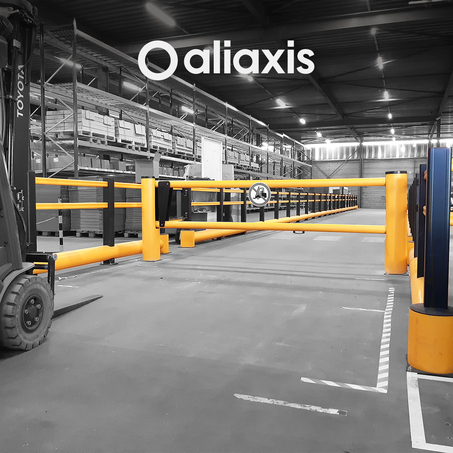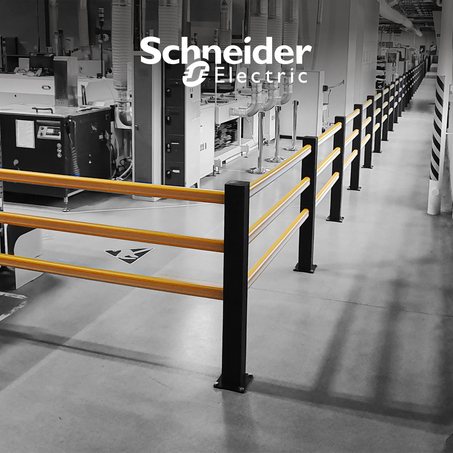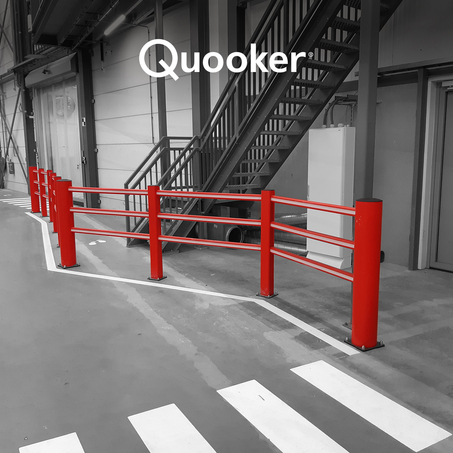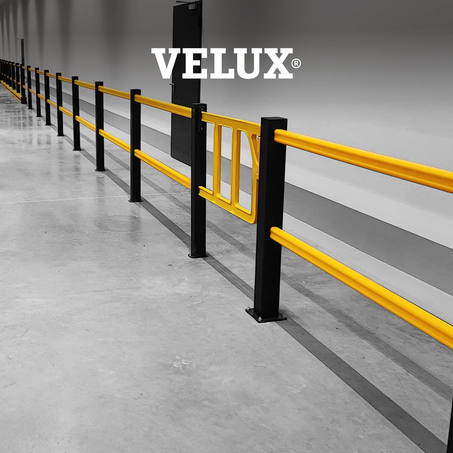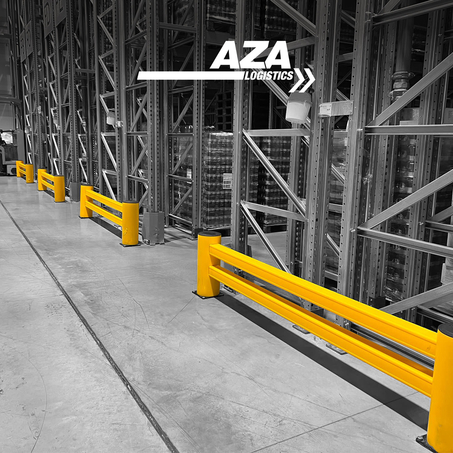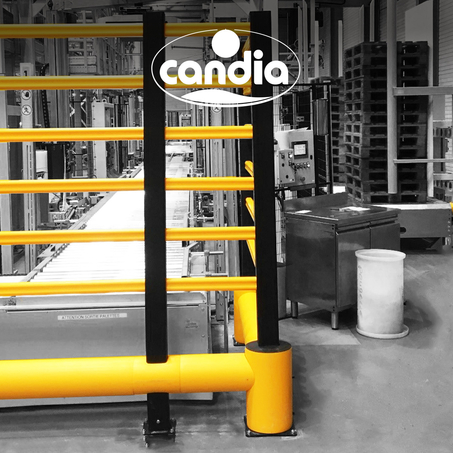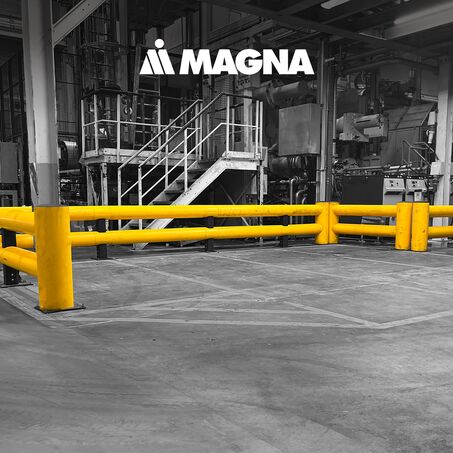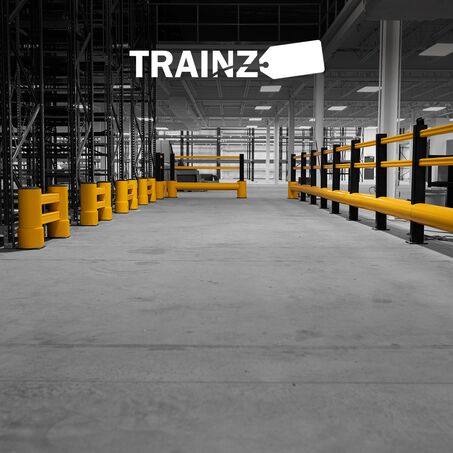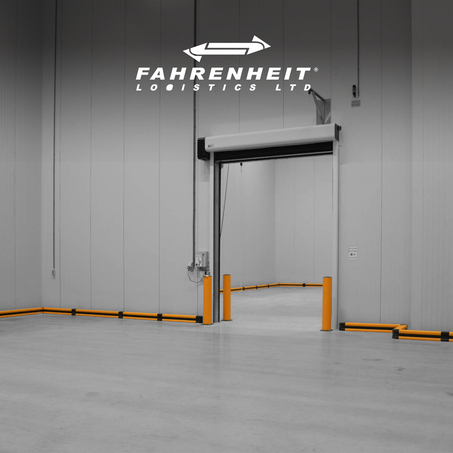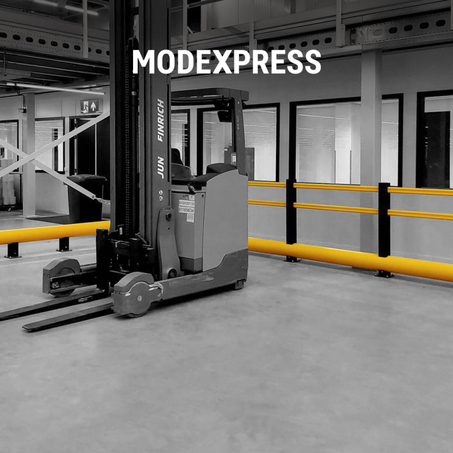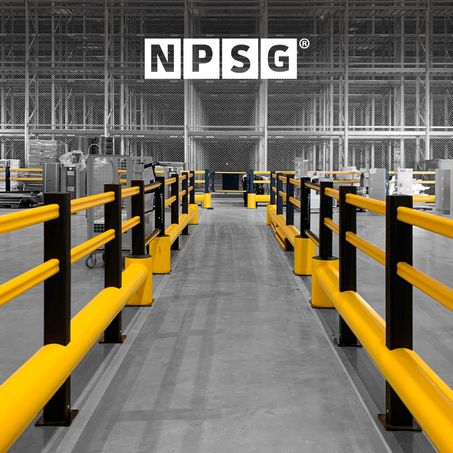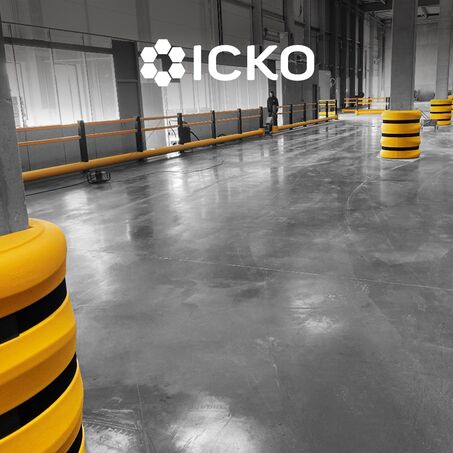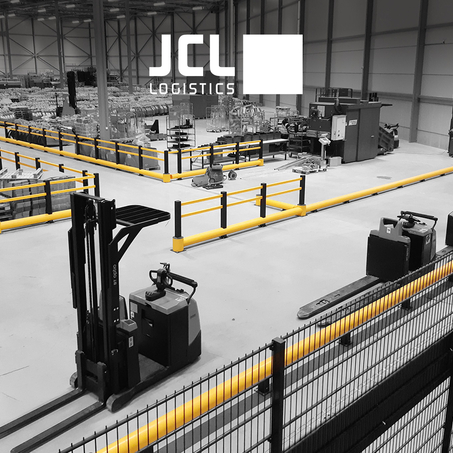Buyer’s guide: safety barriers and handrails
In industrial environments such as warehouses, production facilities, and logistics centres, vehicles like forklifts and pallet trucks are essential to day-to-day operations. However, these vehicles also pose a significant risk to both people and infrastructure. That’s why carefully planned safety barriers and the strategic placement of handrails are vital to preventing accidents and maintaining a safe workplace. Flexible safety barriers absorb impact, while sturdy handrails help define zones and guide traffic flow.
In this buyer’s guide, we outline the key factors to consider when investing in safety solutions.
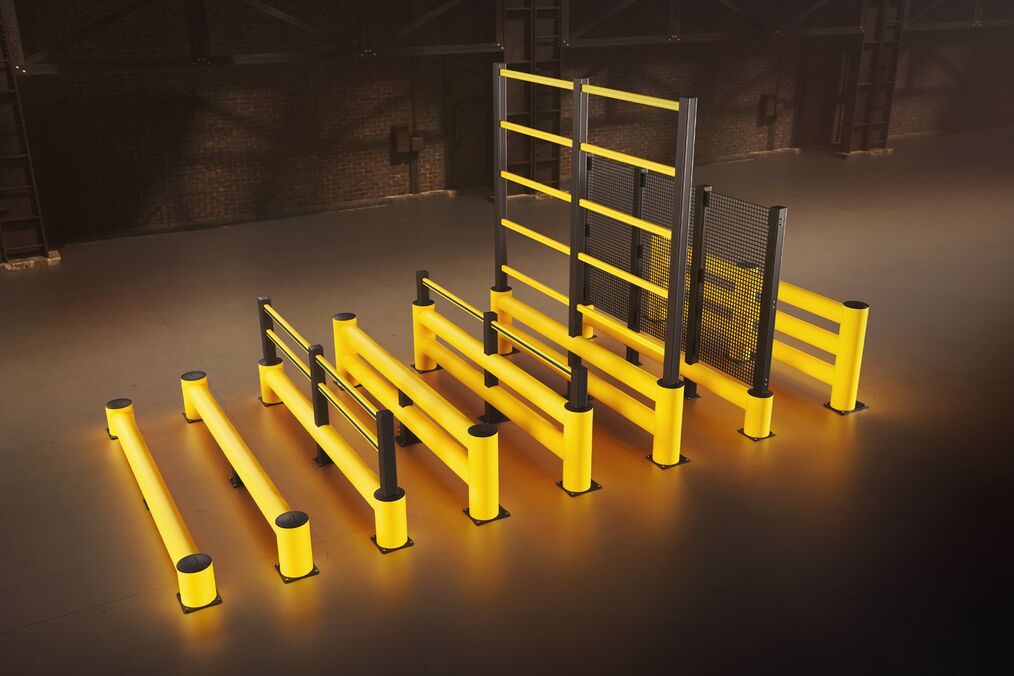
Table of contents
What should you look for when buying safety barriers and handrails?
What should the safety barrier protect?
Is the protection intended to protect employees, storage racks, machinery, loading bays, or critical infrastructure? This will determine the most appropriate type of barrier for the job.
What should handrails protect?
Do you want to protect pedestrians from vehicle traffic? Are the handrails intended for machine guarding or zone separation? The purpose of the handrails determines the required height and impact resistance.
What are the environmental factors?
Are the safety products intended for indoor use or outdoor use? Will they be exposed to temperature fluctuations, moisture, or chemicals?
How busy is the work area and what kind of vehicles are driving around?
In high-traffic areas such as warehouses with frequent forklift movement, you’ll need stronger, more impact-resistant safety barriers than in less active zones. Speed and vehicle weight also matter when selecting the right safety barrier.
What are the key features of safety barriers and handrails?
Focus on flexibility, impact absorption, sustainability and visibility. Flexible polymer barriers absorb impact and return to shape. This makes them more sustainable than metal options.
What about installation?
Need fast installation with minimal disruption? Modular systems are easy to install and expand, keeping downtime low.
What about maintenance?
Safety solutions made from high-quality materials require less maintenance. Flexible barriers last longer than steel ones, which can bend or break on impact.
What happens in a collision?
How much impact can the product handle? What happens to the barrier or handrail afterwards? A good solution prevents damage to vehicles and infrastructure.
What is the budget and the long-term cost?
Lower-cost options may seem appealing, but frequent repairs or replacements drive up the total cost. Choose a long-lasting safety solution with a low total cost of ownership.
Which certifications and standards matter?
Does the safety barrier or handrail comply with relevant EU standards and hold certifications such as TÜV Nord or ISO? These ensure quality and reliability.
Tailored service
Looking to invest in safety barriers and handrails? Take into account several factors, including the risks in your work environment, the intensity of vehicle traffic, and the level of protection required. At Boplan, we’re here to help you make the right choice.
Would you like a quote or more information about our safety barriers or handrails? Get in touch with our team for expert advice and practical guidance.
What should the safety barrier protect?
Safety barriers protect several critical areas within an industrial environment. Depending on what needs to be secured, you can choose specific types of barriers:
1. Employees and other people
In zones where pedestrians are present—such as walkways and crossings—highly visible, impact-resistant flexible barriers are essential. They keep people safely separated from vehicles and reduce the risk of serious injury in the event of a collision.
2. Equipment and machinery
Industrial machinery is valuable and often delicate. Vehicle collisions can lead to expensive repairs and production downtime. Strong, flexible barriers protect equipment without limiting accessibility.
3. Buildings and infrastructure
Structural elements like columns, loading docks, electrical units, and walls are vulnerable to vehicle impact. Well-positioned barriers or handrails help prevent structural damage and costly repairs.
4. Goods and storage racks
Storage racks with goods are particularly susceptible to forklift collisions. Safety barriers reduce the risk of impact to the racking system and prevent stored goods from falling or being destroyed.
When selecting safety barriers, consider both the level of risk and the desired degree of protection. In high-traffic zones, durable, shock-absorbing solutions are the best choice. For low-risk areas, lighter protection options may suffice.
What should handrails protect?
Handrails play a vital role in protecting people in industrial environments. Depending on the application, specific handrail features may be required:
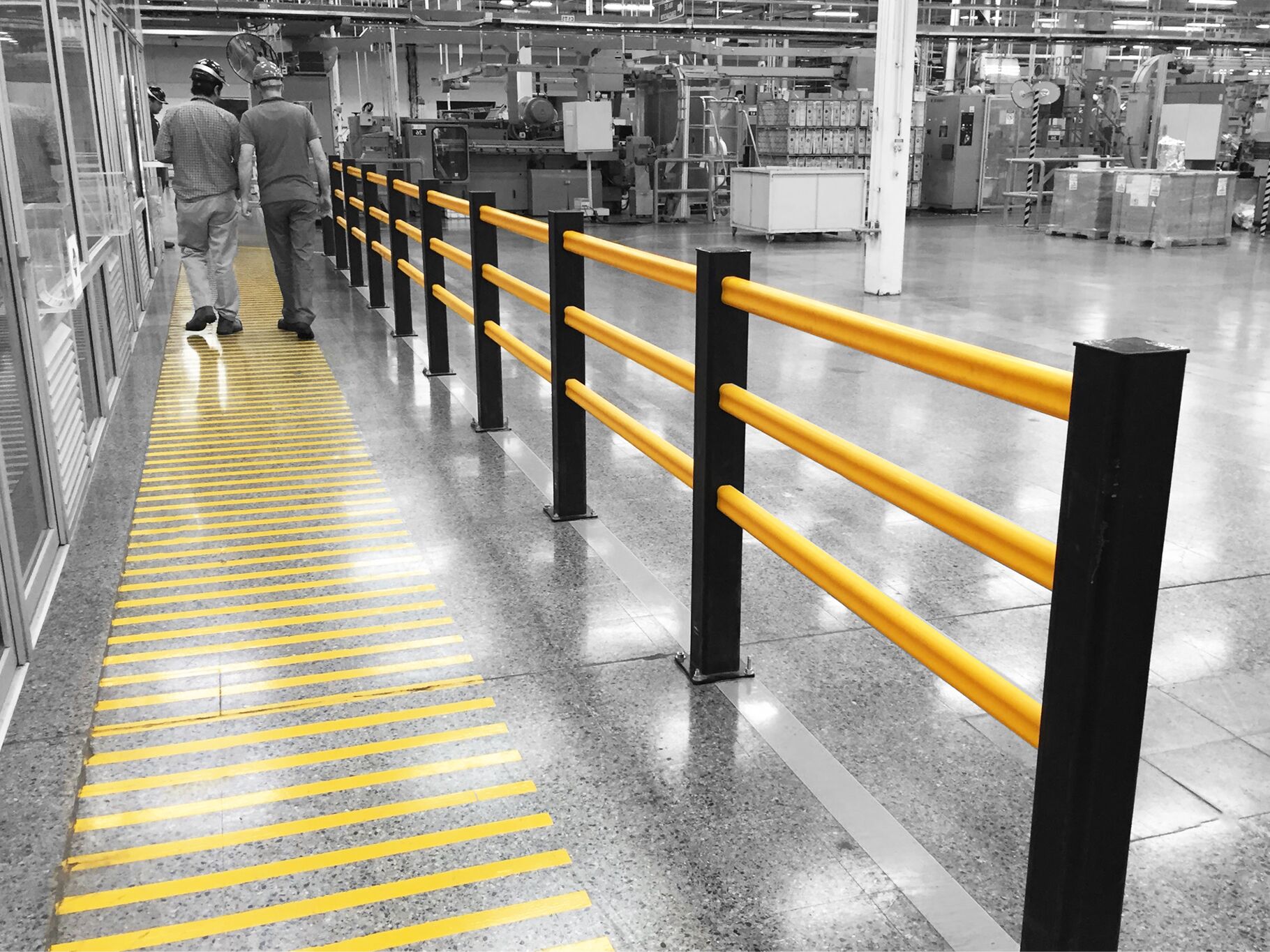
What are the environmental factors where the safety barriers and handrails are placed?
5 key environmental factors to consider:
1. For indoor and outdoor use
Outdoor safety barriers and handrails must withstand exposure to rain, frost, and UV radiation. For outdoor use, materials with high corrosion resistance are recommended.
2. Temperature fluctuations
In environments with extreme temperatures—such as cold storage or near heat sources—materials must withstand expansion, shrinkage, and brittleness.
3. Chemical exposure
In sectors such as the chemical industry, safety solutions must resist aggressive substances and corrosive elements. Polymer barriers are a better choice than metal alternatives, as they do not rust and are more resistant to chemical exposure.
4. Space available
In narrow aisles or narrow production areas, safety barriers need to be compact and efficient. Modular or low-profile barriers are ideal in tight spaces, allowing safe flow for both vehicles and pedestrians.
5. Sector-specific requirements
Different sectors have specific safety needs. A good example is the food industry. Strict hygiene rules apply here. Handrails and barriers must be easy to clean and must not pose a contamination risk. Smooth surfaces and rounded corners help prevent dirt and bacteria build-up.
How busy is the work area, and what types of vehicles operate there?
5 key factors to consider when looking at traffic and vehicles:
1. What type of traffic is there on site?
In environments with heavy-duty traffic, such as forklifts and lorries, you will need robust safety barriers that can absorb high-impact forces. In areas with lighter equipment like hand carts or pallet trucks, lower-impact protection may be sufficient.
2. Is there mixed traffic?
In many workplaces, pedestrians and vehicles share the same space. In such environments, a combination of clear floor markings, handrails, and traffic guidance systems is essential to prevent the risk of collisions. Pay particular attention to crossings and zones where people and vehicles may intersect.
3. How busy is it and are there peak times?
In constantly active areas or during peak operational hours, installing more robust safety elements is essential. Where vehicle manoeuvring is frequent and traffic is intense, barrier systems must be able to withstand repeated impacts and continuous loads.
4. How fast do the vehicles move?
Vehicle speed has a direct impact on safety barrier selection. The faster the vehicle traffic, the greater the impact force in the event of a collision. In areas where higher speeds are permitted, shock-absorbing safety barriers must be used to absorb and distribute the energy effectively.
5. How heavily loaden are the vehicles?
Vehicle load affects the force of a collision. Heavily laden vehicles have longer braking distances and cause more damage on impact. This calls for stronger protection—such as reinforced safety barriers and handrails in high-risk zones.
What are the 4 key features of safety barriers and handrails?
If you are investing in safety barriers and handrails, consider the following important features:
2. Sustainability
How long do your safety barriers and handrails need to last? In high-traffic industrial environments, a long service life helps reduce costs. Flexible polymer safety barriers last longer than metal alternatives, which tend to bend or break on impact and require replacement. Flexible barriers absorb energy and return to shape, reducing damage from impact to vehicles and infrastructure.
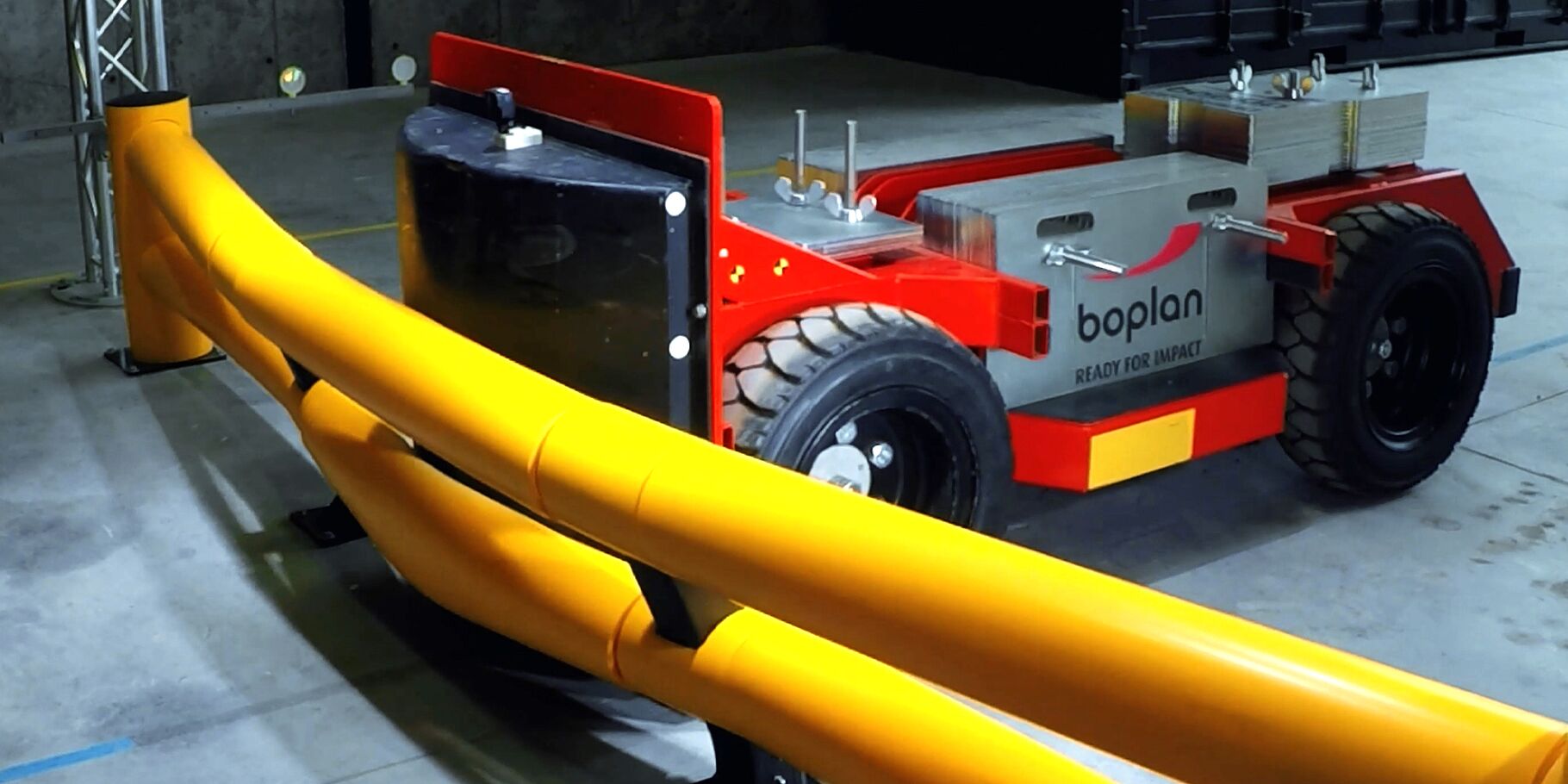
4. Are they clearly visible?
Safety products must be easily visible to both drivers and pedestrians. Key visibility factors include:
Colour: Bright, contrasting colours like yellow and black ensure high visibility.
Height and diameter: Taller barriers or wider bollards improve visibility and awareness.
Size and placement: Well-positioned safety elements help prevent accidents by clearly signalling danger in time.
What about the installation?
Proper installation is essential to ensure the effectiveness and sustainability of safety barriers and handrails. Here are 4 key factors to consider when installing safety barriers and handrails:
1. Is easy installation required?
In operational environments where downtime is expensive, fast and simple installation is crucial. Modular safety solutions are ideal, as they can be installed quickly and without major disruption.
2. Who carries out the installation?
Some safety systems are easy to install yourself, while others require professional support. It is important to check in advance whether certified technicians are needed—and whether this has an impact on your project timeline.
3. Are there location restrictions?
In certain environments, drilling or anchoring in the floor may not be allowed—for example, in clean rooms, cold storage, or warehouses with underfloor heating. In such cases, look for alternatives such as chemical anchoring or freestanding systems.
4. Flexibility and future expansion
Industrial environments often evolve. Choose safety solutions that are easy to adapt or extend as your infrastructure changes.
Tip: Plan your installation to minimise impact on ongoing work. Involve professionals to ensure the system performs as intended.
What about maintenance?
Maintenance is an important factor when choosing safety solutions. It affects not only product lifespan but also total cost of ownership. Here are some key aspects to consider when selecting safety barriers or handrails:
Are parts replaceable, or must the entire system be replaced?
Some safety systems allow for individual parts to be replaced, while others require full replacement after an impact. Flexible polymer protection returns to its original shape after a collision, meaning replacement is often unnecessary. With steel or concrete, deformation is permanent. So the entire barrier must usually be replaced.
What happens in the event of a collision?
Polymer safety barriers and handrails
Imagine the worst-case scenario: a forklift hits a safety barrier or handrail. What happens next?
Polymer safety barriers and handrails are designed to absorb multiple impacts without sustaining permanent damage. Thanks to their flexibility, they absorb the force and return to their original shape. As long as the recommended parameters are followed, polymer safety products offer a lifespan that exceeds operational expectations.
Damage? Repair it as soon as possible
Has damage occurred? Then make repairs as soon as possible. A compromised safety system no longer performs its protective function and may fail to stop a vehicle in the event of another impact. This poses a serious safety risk. Mark and isolate the damaged area with safety tape or movable barriers until repairs are completed.
Save costs with modular systems
A major benefit of modern safety barriers and handrails is their modular design. Instead of replacing the entire unit, you can simply replace the damaged part. This reduces costs and minimises manufacturing downtime. For maximum flexibility, choose a system that is easy to expand and adapt.
By investing in flexible, modular and sustainable safety solutions, you reduce the impact of collisions and ensure your workplace remains fully protected at all times.
What is the budget and what are the long-term costs?
When buying safety barriers and handrails, two key financial factors matter: your initial investment and the long-term cost.
Costs of damage: prevention or repair?
A key financial consideration is how much you are willing to spend on repairs versus investing in a resilient solution that prevents damage. Flexible polymer barriers absorb impact and return to their original shape, reducing damage to both the barrier and the vehicle. Modular systems allow you to replace only the damaged parts—no need for full replacement. This lowers repair costs and ensures fast recovery with minimal disruption.
Which certifications and standards are important?
What safety standards must safety barriers and handrails meet?
Certifications and standards play a crucial role in the selection of safety barriers and handrails. They ensure that the products meet strict safety and quality requirements—especially important in industrial environments.
Depending on the sector and application, safety products must comply with specific standards. Make sure the products have been tested for impact resistance and shock absorption, and that the tests were carried out by an accredited testing centre. This information is usually found in technical documentation such as data sheets.
Reliable safety products comply with recognised standards, including:
- ISO (International Organisation for Standardisation) – set international requirements for quality and safety.
- EN standards (European Standards) – define whether a product meets European regulations for industrial use.
- TÜV certification – provides additional assurance from an independent testing organisation.
Some companies also follow internal guidelines or safety protocols that exceed legal requirements. Check that the safety barriers and handrails you select align with your internal policies and procedures.
In many cases, a tailored proposal is the best option. Do your safety solutions need to meet specific standards? At Boplan, we’ll gladly advise and provide a tailored solution that matches your sector and working environment. Get in touch before making your final decision.
Conclusion
When selecting safety barriers and handrails, it is essential to consider several key factors: workplace risks, the type and intensity of traffic, environmental conditions, and mandatory certifications.
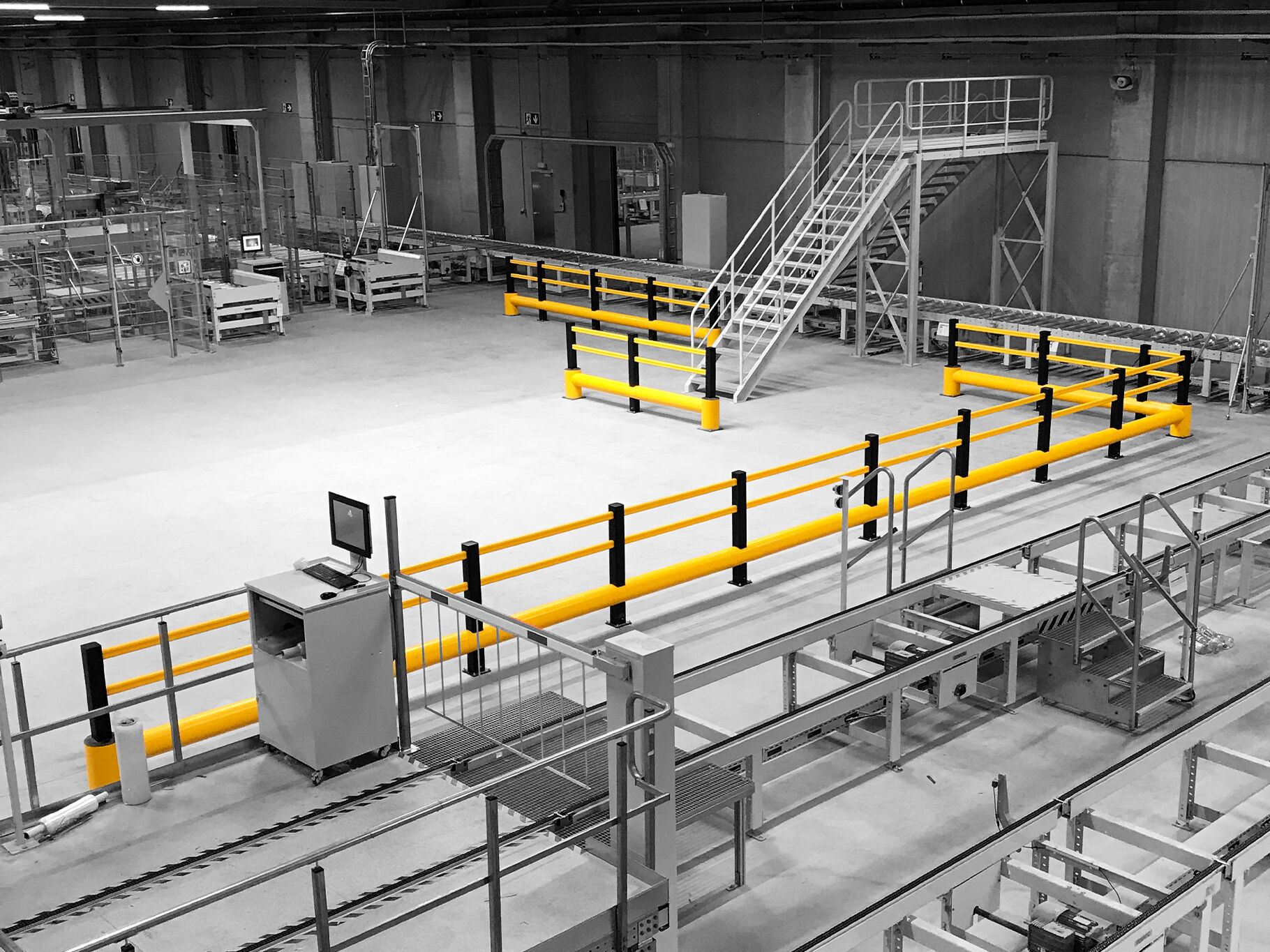
Would you like expert advice on the best safety barriers or handrails for your business? Contact our team. We’ll be happy to help with a sustainable, flexible solution for protecting your people, equipment, scaffolding, infrastructure and buildings.
